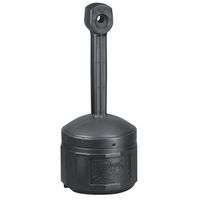Call +(254) 703 030 000 / 751 483 999 / 721 704 777
- Home
- Cleaning And Janitorial
- Waste Recycling Trash Supplies
- Cigarette Disposal
.....Read More
Frequently Asked Questions
What are the best materials for cigarette disposal receptacles?
The best materials for cigarette disposal receptacles are those that are durable, fire-resistant, weather-resistant, and easy to maintain. Common materials include:
1. **Stainless Steel**: Known for its durability and resistance to rust and corrosion, stainless steel is ideal for outdoor use. It is also fire-resistant, making it a safe option for disposing of lit cigarettes.
2. **Aluminum**: Lightweight yet strong, aluminum is another excellent choice. It is resistant to rust and corrosion, and its fire-resistant properties make it suitable for cigarette disposal.
3. **Concrete**: Often used for outdoor receptacles, concrete is extremely durable and fireproof. It can withstand harsh weather conditions and is difficult to vandalize or tip over.
4. **Galvanized Steel**: This material is coated with a layer of zinc to prevent rusting, making it suitable for outdoor environments. It is also fire-resistant and durable.
5. **High-Density Polyethylene (HDPE)**: While not inherently fireproof, HDPE can be treated with fire-retardant chemicals. It is resistant to impact, weather, and UV rays, making it a practical choice for outdoor use.
6. **Ceramic**: Used less frequently, ceramic is non-combustible and can be aesthetically pleasing. However, it is more fragile compared to metal options.
7. **Fiberglass**: This material is lightweight, durable, and can be treated to be fire-resistant. It is also resistant to weather and corrosion.
When selecting materials, consider the location and expected usage of the receptacle. For high-traffic areas, materials like stainless steel or concrete are preferable due to their durability. For areas where aesthetics are important, materials like ceramic or treated HDPE might be more suitable. Always ensure that the receptacle design minimizes the risk of fire and is easy to clean and maintain.
How do you clean and maintain cigarette ashtrays and receptacles?
To clean and maintain cigarette ashtrays and receptacles, follow these steps:
1. **Preparation**: Wear gloves to protect your hands from ash and residue. Gather cleaning supplies such as a brush, mild detergent, disinfectant, and a trash bag.
2. **Emptying**: Remove the ashtray or receptacle from its location. Carefully empty the contents into a trash bag to avoid scattering ash. For receptacles with removable liners, take out the liner and dispose of the contents.
3. **Initial Cleaning**: Use a brush to remove any remaining ash or debris. For stubborn residue, gently tap the ashtray or receptacle to dislodge particles.
4. **Washing**: Fill a basin with warm water and add a few drops of mild detergent. Submerge the ashtray or liner and scrub with a brush or sponge to remove stains and tar buildup. For receptacles, wipe down the interior and exterior with a soapy cloth.
5. **Rinsing**: Thoroughly rinse the ashtray or liner with clean water to remove soap residue. For receptacles, use a damp cloth to wipe away any remaining detergent.
6. **Disinfecting**: Apply a disinfectant spray or solution to the ashtray or receptacle to kill germs and neutralize odors. Allow it to sit for the recommended time before wiping it off.
7. **Drying**: Dry the ashtray or liner with a clean towel or allow it to air dry completely. Ensure the receptacle is dry before reassembling.
8. **Reassembly and Placement**: Reassemble the receptacle, replacing the liner if applicable. Return the ashtray or receptacle to its designated location.
9. **Regular Maintenance**: Establish a routine cleaning schedule based on usage frequency. Regularly check for damage or wear and replace parts as needed to ensure longevity and hygiene.
What are the benefits of using wall-mounted vs. freestanding cigarette receptacles?
Wall-mounted cigarette receptacles offer several benefits over freestanding ones. Firstly, they save space, making them ideal for areas with limited room. By being attached to a wall, they reduce clutter and maintain clear pathways, enhancing safety and accessibility. Wall-mounted units are also less prone to being knocked over or moved, ensuring stability and reducing maintenance needs. They are often positioned at eye level, making them more visible and encouraging proper use, which can lead to a cleaner environment.
In contrast, freestanding cigarette receptacles offer flexibility in placement. They can be strategically positioned in high-traffic areas or moved as needed to accommodate changes in layout or usage patterns. This adaptability can be particularly beneficial for events or temporary setups. Freestanding units often have larger capacities, reducing the frequency of emptying and maintenance. They can also serve as visual cues, guiding smokers to designated smoking areas.
Both types of receptacles can be designed to be weather-resistant and durable, but wall-mounted units may have an edge in terms of security, as they are less likely to be stolen or vandalized. However, freestanding receptacles can be weighted or anchored to enhance stability and security.
Ultimately, the choice between wall-mounted and freestanding cigarette receptacles depends on the specific needs of the location, including space availability, traffic patterns, and aesthetic preferences. Each type offers distinct advantages that can contribute to a cleaner, more organized, and safer environment.
How do cigarette receptacles help in reducing fire hazards?
Cigarette receptacles play a crucial role in reducing fire hazards by providing a designated, safe place for the disposal of cigarette butts, which are a common cause of fires. These receptacles are typically made from fire-resistant materials, such as metal or specialized plastics, which prevent the ignition of surrounding materials. By containing the heat and embers from discarded cigarettes, they significantly reduce the risk of accidental fires.
Moreover, cigarette receptacles are often designed with features that further enhance safety. For instance, they may have a sand or water-filled base that extinguishes the cigarette upon contact. Some receptacles are equipped with self-extinguishing mechanisms that cut off the oxygen supply, effectively putting out the cigarette. These features ensure that even if a cigarette is not fully extinguished before disposal, it will not ignite other materials.
The strategic placement of cigarette receptacles in areas where smoking is permitted or likely to occur, such as outside buildings, in parking lots, or at designated smoking areas, encourages smokers to dispose of their cigarettes properly. This reduces the likelihood of cigarettes being discarded carelessly on the ground, where they can easily ignite dry leaves, paper, or other flammable materials.
Additionally, by providing a convenient and visible option for disposal, cigarette receptacles help in promoting responsible smoking behavior. This not only minimizes fire risks but also contributes to a cleaner environment by reducing litter. In summary, cigarette receptacles are an effective fire prevention tool, combining material safety, design features, and strategic placement to mitigate the risk of fires caused by improperly discarded cigarettes.
What are the environmental impacts of improper cigarette butt disposal?
Improper disposal of cigarette butts significantly impacts the environment. Cigarette butts are the most littered item globally, with trillions discarded annually. They contain cellulose acetate, a type of plastic that is not biodegradable, leading to persistent environmental pollution. When discarded on the ground, cigarette butts can take up to 10 years to decompose, during which they release toxic chemicals such as nicotine, arsenic, and heavy metals into the soil and waterways.
These chemicals can leach into the soil, affecting plant growth and soil health. In aquatic environments, the toxins from cigarette butts can be lethal to marine life. Fish, birds, and other wildlife often mistake cigarette butts for food, leading to ingestion that can cause digestive blockages, poisoning, and even death. The presence of cigarette butts in water bodies can also degrade water quality, affecting both ecosystems and human health.
Moreover, cigarette butt litter contributes to urban pollution, clogging drains and leading to increased maintenance costs for municipalities. During rainfall, these butts can be swept into stormwater systems, eventually reaching rivers, lakes, and oceans, exacerbating water pollution.
The visual pollution caused by cigarette butts also diminishes the aesthetic value of natural landscapes and urban environments, potentially affecting tourism and local economies. Additionally, the risk of fire is heightened by improperly discarded cigarette butts, which can ignite dry vegetation and lead to wildfires, causing further environmental destruction and loss of biodiversity.
Overall, the improper disposal of cigarette butts poses a significant threat to environmental health, necessitating increased public awareness, stricter regulations, and effective waste management strategies to mitigate their impact.
How can businesses encourage proper cigarette disposal in smoking areas?
Businesses can encourage proper cigarette disposal in smoking areas through several strategies:
1. **Strategic Placement of Receptacles**: Place cigarette disposal bins at convenient and visible locations within designated smoking areas. Ensure they are easily accessible and within a short distance from where people typically smoke.
2. **Clear Signage**: Use clear and visible signs to direct smokers to disposal bins. Signs should communicate the importance of proper disposal and the environmental impact of littering.
3. **Designated Smoking Areas**: Clearly define and maintain designated smoking areas to concentrate disposal efforts. This helps in managing waste and keeping other areas clean.
4. **Aesthetic and Functional Design**: Use aesthetically pleasing and functional disposal units that blend with the environment. Units should be weather-resistant, easy to use, and have a design that encourages use.
5. **Incentive Programs**: Implement incentive programs that reward proper disposal. This could include discounts, loyalty points, or small rewards for using disposal bins.
6. **Awareness Campaigns**: Conduct awareness campaigns to educate smokers about the environmental and social impacts of improper disposal. Use posters, flyers, or digital media to spread the message.
7. **Regular Maintenance**: Ensure regular maintenance and emptying of disposal bins to prevent overflow and maintain cleanliness. This encourages continued use and prevents littering.
8. **Employee Training**: Train staff to promote and monitor proper disposal practices. Employees can gently remind customers to use the bins and report any issues with disposal units.
9. **Community Engagement**: Engage with local communities and environmental groups to promote anti-littering initiatives and collaborate on solutions for cigarette waste management.
10. **Feedback Mechanism**: Provide a way for customers to give feedback on the smoking area facilities, allowing businesses to make improvements based on user suggestions.
What are the regulations or guidelines for cigarette disposal in public areas?
Regulations and guidelines for cigarette disposal in public areas vary by country and region, but generally focus on preventing litter, reducing fire hazards, and protecting the environment. Common regulations include:
1. **Designated Smoking Areas**: Many public spaces designate specific areas for smoking, equipped with appropriate disposal units like ashtrays or cigarette bins to encourage proper disposal.
2. **Littering Laws**: Many jurisdictions classify improper disposal of cigarette butts as littering, subject to fines. These laws aim to reduce environmental pollution and maintain cleanliness in public areas.
3. **Fire Safety Regulations**: In areas prone to wildfires, strict regulations may prohibit smoking or require the use of fire-safe disposal containers to prevent accidental fires.
4. **Public Awareness Campaigns**: Governments and organizations often run campaigns to educate the public on the environmental impact of cigarette litter and promote responsible disposal practices.
5. **Provision of Disposal Units**: Public areas, especially those with high foot traffic, are often required to provide adequate disposal units to facilitate proper disposal and reduce littering.
6. **Environmental Protection Laws**: Some regions have specific laws targeting the reduction of cigarette waste due to its harmful impact on wildlife and ecosystems, encouraging recycling and proper disposal.
7. **Penalties and Fines**: Enforcement of cigarette disposal regulations often involves penalties for non-compliance, including fines for individuals caught littering cigarette butts.
8. **Corporate Responsibility**: Some guidelines encourage or require tobacco companies to contribute to the cost of cleaning up cigarette waste or to develop biodegradable filters.
These regulations aim to mitigate the negative impact of cigarette waste on the environment and public health, while promoting responsible behavior among smokers.


